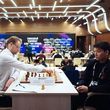24 February 2017
A Principled Opening Duel in Kemerovo
IM Nikolai Vlassov shares his experience exploring the wilds of the Sicilian Defense.
I am going to open with some background. I have been more or less successfully employing the 2.c3 Sicilian as White for many years and was aware that despite there being only a few lines with some advantage for White, it was invariably an interesting complex fight, which I generally managed to handle better than my opponents.It used to be the case until my game with Anastasia Savina.
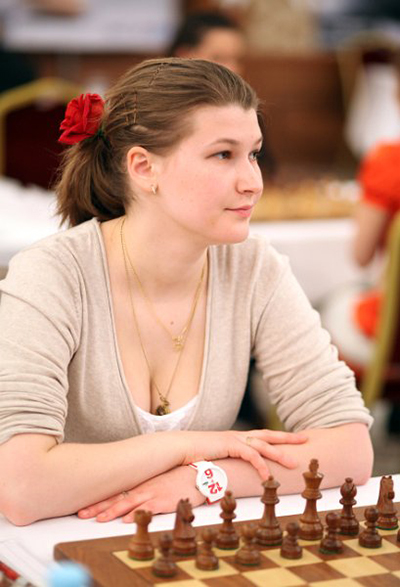
Vlassov – Savina
Moscow 2009
1.e4 c5 2.c3 Nf6 3.e5 Nd5 4.d4 cxd4 5.cxd4 d6 6.Nf3 Nc6 7.Bc4 dxe5.
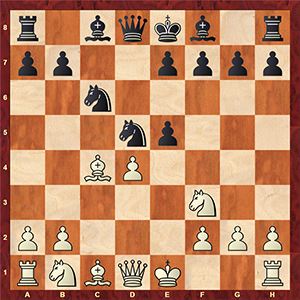
This move has never happened in my practice, however surprising it may sound. Black would usually opt for 7…Nb6 or 7…e6.
8.Bxd5.
Seems like the only way to challenge Black’s idea. White stands to gain nothing from 8.dxe5 Ndb4 (or 8...Nb6), whereas the type of positions after 8.Nxe5 e6 is not to my taste despite a definite amount of fighting potential in them.
8...Qxd5 9.Nc3 Qd6 10.d5 Nd4 11.Nxd4 exd4 12.Qxd4 e5.
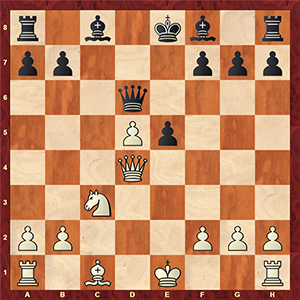
This position is critical to the entire line.
13.Qe3.
One of three possible queen retreats. 13.Qc4 Bd7 14.0–0 is a rough equality, while 13.Qd3 was tried by me in the below game.
13...Be7 14.0–0 0–0 15.Re1 f6 16.f4 Bd8!
It it already obvious that White got nothing out of the opening and it's time to run for it. However, several moves made by inertia and out of unjustified stubborn willingness to win rendered my position quite hopeless.
17.Kh1 Bb6 18.Qf3 Bf5 19.g4 (19.Be3 Ba5) 19...Bg6 20.f5 Bf7 21.Be3 Bd4 22.Rad1 Bxc3 23.bxc3 Rfd8 24.c4 b5 25.g5 bxc4 26.Qg4 Bxd5+ 27.Kg1 Kh8 28.Qh4 Qf8 29.gxf6 gxf6 30.Kf2 Rab8 31.Re2 c3 32.Rg1 Qf7 33.Rg6 Rg8 34.Qxf6+ Qxf6 35.Rxf6 Rb2 36.Bh6 Bc4. 0-1.
Black's offensive, amplified by opposite-colored bishops, made a great impression on me, let alone the fact of suddenly finding myself deprived of the opening that I had been playing for so many years, and all this without any special efforts - suffice it to have a look at this short and unsophisticated game.
I even spent several days studying the position, but nothing helped as Black is OK in all lines with no way to put him up against any difficulties and sly pitfalls.
Having moved to Kemerovo, I hoped that no one would give my games a close study and it would be no problem relying on my old stock of ideas. In general, this hope of mine came true, but not against the strongest player of Kuzbass, contesting whom has gained quite a number of years now.
Vlassov – Nevostrujev
2011 Championship of Kemerovo Region
1.e4 c5 2.c3 Nf6 3.e5 Nd5 4.d4 cxd4 5.cxd4 d6 6.Nf3 Nc6 7.Bc4 dxe5 8.Bxd5 Qxd5 9.Nc3 Qd6 10.d5 Nd4 11.Nxd4 exd4 12.Qxd4 e5 13.Qd3.
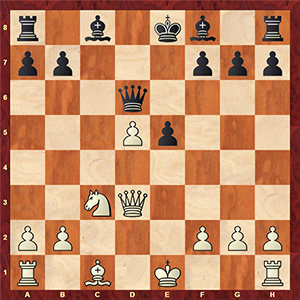
On realizing that Vladimir had prepared for this encounter, I attempted to deviate.
13...Qa6.
Neither are there any problems for Black after 13...Bd7 14.0–0 Qg6 15.Qe2 Bd6 16.f4 0–0 17.fxe5 Rae8 18.Bf4 Bxe5 19.Bxe5 f6.
14.Qg3?!
Better was to transit into an endgame – 14.Qxa6 bxa6 15.f4 Bd6 16.Ne4 (16.0–0) 16...Bc7 (16...Bb4+ 17.Bd2 Bxd2+ 18.Kxd2 exf4 19.Rhf1) 17.0–0 Bb7 (17...0–0), and although White's play is more demanding there, the position is about equal.
14...f6 15.f4 e4! 16.Be3 (16.Nxe4? Bf5 17.Nc3 Kf7 18.Be3 Rc8 19.Kf2 Ba3! with advantage for Black) 16...Bf5 17.Kf2 Kf7 18.Rhd1 Bb4 19.Ne2 (19.Bd4) 19...h5 20.h3 h4 21.Qh2 Rac8.
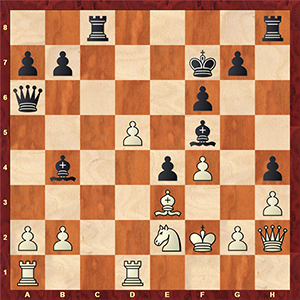
The opening results can be summed up now in that a misplaced h2-queen secures advantage for Black. The game that ensued, not a faultless one, also proved me second best.
22.Nd4 Rh5 23.Rdc1 Rxc1 24.Rxc1 Bd6 25.Qh1 Qxa2 26.Qd1 g6 27.Qc2 Bd7 (27...Qxd5 28.Ne2) 28.Nb3 Qa4 29.Ra1 Qb4 30.Bd2 Qb6+ 31.Be3 Qb4 32.Bd2 e3+ 33.Bxe3 Rxd5 34.Rxa7 Bxf4 35.Qc3 Bg3+ 36.Kf3 Qb5 37.Bd4 Qf1+ 38.Ke3 Bf4+ 39.Ke4 Qxg2+ 40.Qf3 Bf5+. 0-1.
Upon looking into the mainline for another couple of days for conscience's sake, I finally resigned myself to the fact that I had nothing to go after. I once essayed 2.f4 (the move that had me victorious in game two against Savina), lost a game and switched to a rare line 6.Bc4, which has become become a pivotal topic of our further confrontation with Vladimir Valerianovich on the one hand and of this article on the other. The very first experience was a success and an inspiration.

Vlassov – Nevostrujev
Kuzbass Championship Superfinal, Kiselevsk 2012
1.e4 c5 2.c3 Nf6 3.e5 Nd5 4.d4 cxd4 5.cxd4 d6 6.Bc4.
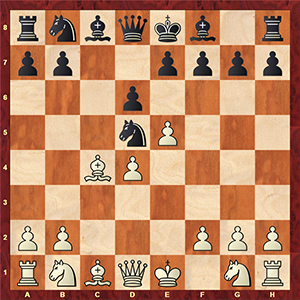
6...Nb6 7.Bb3 dxe5 8.Qh5 e6 9.dxe5 Qd3 10.Nc3 Bd7?!
Usually they play something like 10...Nc6 11.Be3 Bb4 12.Nge2 Nc4 13.Rd1 Qe4 14.Bxc4 Bxc3+ 15.Nxc3 Qxc4 16.f4.
11.Nge2 (11.Bd2) 11...Nc6 12.Nf4!?
12.0–0 Qg6 13.Qxg6 hxg6 14.Nb5 Rc8 15.Be3 a6 16.Nd6+ Bxd6 17.exd6 Nd5 18.Bxd5 exd5 19.Rac1 (19.Rad1 Be6 20.Nf4 Kd7 21.Nxd5 Bxd5 22.Rxd5) 19...Be6 20.Bc5 Kd7 21.Rfd1 Rh4.
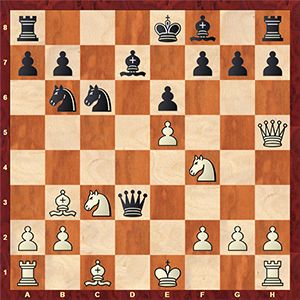
Having been a first-timer to this setup, Vladimir made up his mind to play it safe and blundered immediately.
12...Qf5?
Black needed to opt for a brave 12...Qa6! 13.Be3 (13.Bxe6 Bxe6 14.Nxe6 fails to 14…g6 15.Nc7+ Kd7).
13.Qxf5 exf5 14.0–0 0–0–0 15.e6! fxe6 16.Nxe6 Re8 17.Ng5 (even stronger 17.Nxf8 Rexf8 18.Bf4 with a substantial edge for White) 17...Na5 18.Be3 Nbc4 19.Bxa7 Be7 20.Nf3 Nxb2 21.Bd4 (21.Bf7) 21...Nbc4 22.Rfc1 Bc6 23.Na4! b5 24.Bxc4 Nxc4 25.Nb6+ Kb7 26.Nxc4 bxc4 27.Rxc4 Rc8 28.Rb1+ Ka8 29.Ne5 Rb8 30.Rbc1 (immediately decisive was 30.Bb6) 30...Bb5 31.Rc7 Rb7 32.Rxb7 Kxb7 33.Rb1 Ka6 34.a4! Be8 35.Rb6+ Ka5 36.Rb8 Kxa4 37.Nc4 Rg8 38.Nb6+ Ka3 39.Nd5 Bg5??
This is a time trouble blunder, but after 39...Bd6 40.Rd8 Bb4 41.Bxg7 White should prevail anyway.
40.Bc5+ Ka4 41.Nc3+. 1-0.
Vlassov – Nevostrujev
Governor's Cup, Kemerovo 2013
1.e4 c5 2.c3 Nf6 3.e5 Nd5 4.d4 cxd4 5.cxd4 d6 6.Bc4 Nb6 7.Bb3 Bf5.
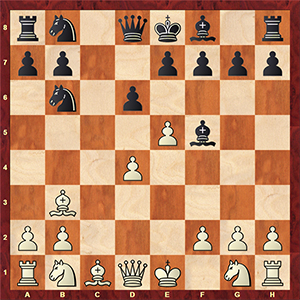
8.Qf3?
I keep making his mistake again and again. Facing a new move at the board, I immediately start looking for a refutation and, "thanks to" my irrepressible optimism, I often indulge in wishful thinking. A host of lines below has nothing to do with this game - it's a titanic preparation for the upcoming one.
8.Nf3 e6 9.Nc3;
8.e6 Bxe6 (8...fxe6 9.Nc3 Nc6 10.Nf3 d5 11.0–0 g6 12.h3 h5 13.Re1 Bg7 14.Bc2 0–0 15.Bxf5 exf5 16.Bf4 Qd7 17.b3 Rae8 18.Ne5 Bxe5 19.Bxe5 f4 20.Qf3 e6 21.Bxf4 Nxd4 22.Qd3 Rxf4 23.Qxg6+ Qg7 24.Qxe8+ Rf8 25.Qxh5 Nf3+ 26.Kh1 Nxe1 27.Rxe1 Qxc3 28.Rxe6 Qc1+ 29.Kh2 Qf4+ 30.Kh1) 9.Bxe6 fxe6 10.Nf3 Nc6 11.0–0
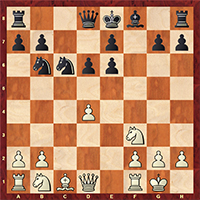
a) 11...Qd7 12.Re1 g6 13.Ng5 e5 14.dxe5 Nxe5 15.Nc3 h6 16.f4 hxg5 17.fxe5 d5 (17...dxe5 18.Qb3) 18.Bxg5 e6 19.Qg4;
b) 11...Qc8 12.Re1 g6 13.Na3 (13.Ng5 Nd8 14.h4 Bg7 15.Na3 Nd5 16.Qd3 Nb4 17.Qb5+ Nbc6 18.Nc2 0–0 19.Qd3 Rf5 20.h5 h6 21.Nf3 g5 22.Bd2 Qd7 23.Bc3) 13...Bg7 14.Ng5
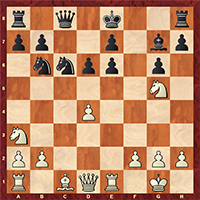
b1) 14...e5 15.Qb3 d5 16.dxe5 Nxe5 17.Be3 h6 18.Bxb6 axb6 19.Nh3 Qg4 20.Rad1;
b2) 14...Nd8 15.Qb3 d5 (15...Bxd4 16.Nb5 Bc5 17.Nxe6 Nxe6 18.Rxe6 d5 19.Bh6 a6 20.Nd6+ Bxd6 21.Rxd6 exd6 22.Qxb6) 16.Bf4 0–0 17.Rac1 Qd7 18.Qe3 Rc8 19.b3;
b3) 14...Nxd4 15.Be3 Nc6 16.Bxb6 axb6 (16...Bxb2 17.Nxe6 axb6 18.Nc4 Be5 19.Qd5 Nb4 20.Qb5+ Nc6 21.Nxe5 Ra5 22.Qc4 Rxe5 23.Rxe5 dxe5 24.Rd1 b5 25.Qd5 h6 26.h3) 17.Nc4 Nd4 18.Nxb6 (18.Nxe6 Nxe6 19.Nxb6 Qd8 20.Nxa8 Nc5 21.Rb1 Be5 22.Rxe5 dxe5 23.Qxd8+ Kxd8 24.Rd1+ Ke8 25.Nb6) 18...Qc5 19.Nxa8 (19.Nxe6 Qxb6 20.Nxg7+ Kf7 21.Ne6 Nxe6 22.Qf3+ Ke8 23.Rxe6 Rf8 24.Qe2 Rf7 25.Re1 Qc7 26.a3) 19...Qxg5 20.Nc7+ Kd7 (20...Kf7 21.Rc1 Rc8 22.Kh1 Kg8 23.Re4 e5 24.Rc4 Rb8 25.f4 Qf5 26.Qd3 e6 27.g4 Qf7 28.Rcxd4 exd4 29.Nxe6 Bf6 30.Qb3) 21.Rc1 Qa5 22.b4 Qxa2 23.Nxe6 Nxe6 24.Rc2 Qa6 25.Rce2 Bc3 26.Rxe6 Bxe1 27.Rxe1.
8...e6 9.Ne2.
I immediately spotted that nothing good would come of the preintended 9.d5?! N8d7 (or 9...Qc8) 10.dxe6 fxe6 11.exd6 Bxd6 with advantage for Black.
9...dxe5 10.dxe5 Nc6 11.0–0 (11.Qg3) 11...Qd3! 12.Bf4? (12.Be3 Be4 13.Qh3 Qxe2 14.Nc3 Bf5 15.Nxe2 Bxh3 16.gxh3 Nxe5 would be the lesser of evils) 12...Qxf3 (even stronger is the immediate 12...g5) 13.gxf3 g5 14.Be3 (simply bad is 14.Bg3? Bh3 15.Rd1 h5) 14...Nxe5 15.Nd4 Bh3 16.Rc1 (16.Rd1) 16...Bg7 17.Kh1 (17.Rc7) 17...Rd8 (17...Nd3) 18.Rd1 (18.Na3) 18...Nec4 19.Na3 Nxb2 (19...Nxe3 20.fxe3) 20.Rd2 N2a4 21.Nab5 a6!? 22.Nc7+ Ke7 23.Bxg5+ (23.Nxa6; 23.Rb1) 23...Bf6 24.f4 Rhg8! 25.Rad1 Bxg5 26.fxg5 Nc3 (26...Rc8) 27.Re1 Rxg5 28.Ncxe6 (28.f4 Rh5 29.Bxe6 fxe6 30.Ncxe6 Rxd4 31.Ng5+ Kf6 32.Rxd4) 28...fxe6 29.Nxe6.
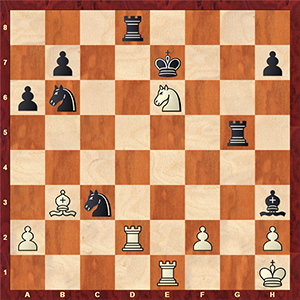
Following a hopelessly failed opening, I managed to provoke a sharp struggle towards time pressure and I was full of optimism, when all of a sudden...
29...Re5!!
A similar trick was employed by Navara to defeat Eljanov, but Nevostrujev's combination is far more complex and spectacular.
30.Rxe5 Rxd2 31.Nf4+ (31.Nc5+ Kd8 32.Nxb7+ Kc8 33.Rc5+ Kxb7 34.Rxc3 Bf5) 31...Kd6 32.Re3 Nd1! This is a final counter-intuitive move to doom White's situation.
33.Rg3 Nxf2+ 34.Kg1 Bd7 35.Rg2 Ne4 36.Rg7 Ke5 37.Nh5 Bc6 38.Rxh7 Nd5 39.h4 Nef6 40.Nxf6 Nxf6 41.Rg7 Rd4 42.Kf2 Rxh4 43.Ke3 Rh3+ 44.Kd2 Ne4+ 45.Kc1 Kd4 46.Kb2 a5 47.Be6 Rg3 48.Rc7 Nc5 49.Bf5 Rg2+ 50.Ka1 Bd5 51.Bb1 Rg1 52.Kb2 Na4+ 53.Ka3 Nc3 54.Bc2 Nb5+. 0-1.
Vlassov – Nevostrujev
Kuzbass Championship Superfinal, Kiselevsk 2013
1.e4 c5 2.c3 Nf6 3.e5 Nd5 4.d4 cxd4 5.cxd4 d6 6.Bc4 Nb6 7.Bb3 Bf5.
The preparation paid off - we share much in the way stubbornness and curiosity.
8.e6.
This is a well-known move, which is not worthy of an exclamation mark, neither does it bring any advantage. However, the first player's task is easier, especially with a certain amount of home preparation under his belt.
8…Bxe6 9.Bxe6 fxe6 10.Nf3 Nc6 11.0–0 g6 12.Re1 Qd7 13.Ng5 e5 14.dxe5 Nxe5 15.f4 Nf7 16.Qd4 Rc8.
Stronger is a computer-suggested 16...e5, but this is by no means an easy decision for a human player to take at the board. E.g., 17.Nxf7 Kxf7 18.fxe5 dxe5 19.Qxe5 Bd6 20.Rf1+ Kg8 21.Qg5 Qc7 22.Nc3 Bxh2+ 23.Kh1 Re8 24.Be3 Be5 25.Rae1.
17.Na3.
Also strong is 17.Nc3 Rc4 18.Nce4 Ne5 19.Qd1 d5 20.b3 Rc6 21.Bb2 Bg7 22.Nc5 Rxc5 23.Bxe5 Bxe5 24.Rxe5 Qc6 25.Qe1 Qf6 26.Qb4 Nd7 27.Rae1 Nxe5 28.Qxc5 Nc6 29.Ne6 d4 30.Qd5 h5 31.b4 a6 32.a4.
17...Bh6.
Better still was 17...e5 18.Nxf7 Kxf7 19.fxe5 dxe5 20.Qxe5 Bc5+ 21.Be3 Rhe8 22.Qf4+ Kg8 23.Bxc5 Rxc5.
18.Ne6 Qa4?!
This is already a decisive error, 18...Rg8 was a tougher defense.
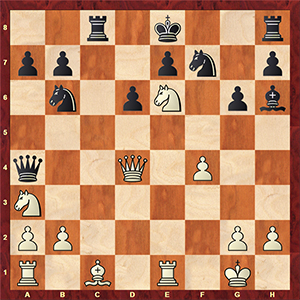
19.b4! Rg8 20.Bb2 Nd8? (20...Qd7 21.Re4 Nd8 22.Rae1 Nxe6 23.Rxe6) 21.Qe4.
Even though it does not let go of the edge, and immediate crusher was 21.Nc5! Rxc5 (21...dxc5 22.Rxe7+! Kxe7 23.Re1+ Ne6 24.Qf6+ Kd7 25.Qf7+ Kc6 26.Rxe6+) 22.Qxd6 Qd7 23.Qxc5.
21...Qc6 22.Qe2 Qd7 23.Nc5 Rxc5 (23...dxc5 24.Rad1) 24.bxc5 Nc8 25.cxd6 Nxd6 26.Be5 N6f7 27.Rad1 Qe6 28.Nb5 Kf8 29.Nc7 Qb6+ 30.Kh1 Nxe5 31.Rxd8+ Kf7 32.Qxe5. 1-0.
Besides classical duels, we had a number of rapid and blitz games played between us, here is one of them.
Vlassov – Nevostrujev
Kemerovo 2014
1.e4 c5 2.c3 Nf6 3.e5 Nd5 4.d4 cxd4 5.cxd4 d6 6.Bc4 Nb6 7.Bb3 dxe5 8.Qh5 e6 9.dxe5 Nc6 10.Nc3 Qd3 11.Nf3 (11.Bf4 Qg6 12.Qxg6 hxg6 13.Nf3) 11...Qg6 (11...Nc4 12.a3) 12.Qh3 h5.
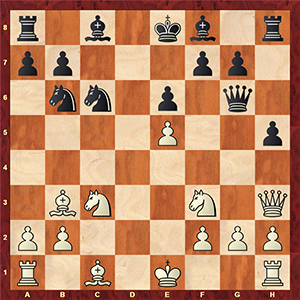
13.Be3.
Both more interesting and stronger is 13.Bg5 Nxe5 (13...Bd7!?) 14.0–0–0 Bd7 15.Bc2 f5 16.Nxe5 Qxg5+ 17.Kb1 Qf6 18.Rhe1 0–0–0 19.Bb3 Be8 20.Rxd8+ Kxd8 21.Nd3 Bd7 22.Qg3 Nc8 (22...f4!? 23.Qf3 Kc8 24.Ne4 Qf5 25.Qxf4 Qxf4 26.Nxf4; 22...Kc8 23.Rc1 f4 24.Nxf4 h4 25.Ne4+ Kb8 26.Nxf6 hxg3 27.Nxd7+ Nxd7 28.hxg3) 23.Ne5 Bd6 24.Nxd7 Bxg3 (24...Kxd7 25.Bxe6+) 25.Nxf6 Bxf2 26.Rd1+ Ke7 27.Nd7 Rd8 28.Ne5 Rxd1+ 29.Nxd1.
13...Qg4 14.0–0–0 (this is too risky, 14.Qg3 should have been preferred) 14...Qxh3 15.gxh3 Bd7 16.Kb1 Ne7 17.Nd4 Ned5 18.Nxd5 Nxd5 19.Bxd5 exd5 20.Rhg1 g6 21.f4 Be7 22.Ne2 (22.f5 gxf5 23.Rgf1) 22...Bxh3 23.Rxd5 0–0 24.Nd4 Rfd8 25.Rxd8+ Rxd8 26.f5 Bc5 27.Nc2.
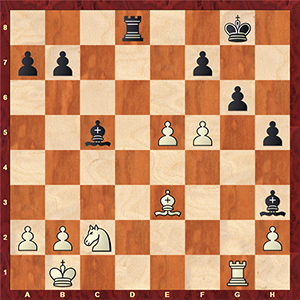
I was hoping to get a good game against what I believed was a trapped h3-bishop, but bad luck was in store for me instead.
27...Bxf5! 28.Bxc5 Rd2 29.Rc1 Rxh2 30.Bxa7 (30.Bd6 Rg2 31.e6 fxe6 32.b4 h4 33.Kb2 Re2) 30...h4 31.e6 fxe6 32.b4 h3 33.Bb8 Rg2 34.a4 Kf7 35.Kb2 h2 36.Bxh2 Rxh2. 0-1.
Vlassov – Nevostrujev
Kuzbass Championship Superfinal, Kiselevsk 2014
1.e4 c5 2.c3 Nf6 3.e5 Nd5 4.d4 cxd4 5.cxd4 d6 6.Bc4 Nb6 7.Bb3 dxe5 8.Qh5 e6 9.dxe5 N6d7!?
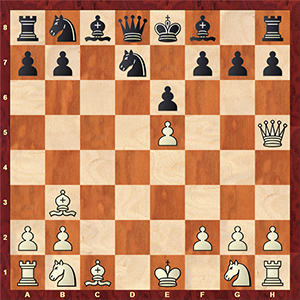
This strange-looking and strong move was not a novelty for me since I had already lost a rapid game to Nevostrujev in this line shortly before. This is moving same piece twice in the opening, and backwards at that, while the rest of the army is still undeveloped. This is not a non-category player's type of error though, but rather an attempt to overtake initiative by Black. Black's most misplaced piece, the b6-knight, is rerouted to excellent outposts on e5 or c5 (and in certain lines it even lands on d3 to check the white king), while the black queen gets access to an important a5-square.
10.Nf3 g6 11.Qh3!
In the above-mentioned source rapid game I failed to bail out from the difficult endgame after 11.Qg5 Bg7!
11...Bg7.
There are many interesting complex lines arising after 11...Nxe5 12.0–0 or 12.Nxe5 Qa5+ 13.Nc3 Qxe5+ 14.Be3. White is well compensated for the missing pawns in every case.
12.0–0 Nc6 13.Rd1 0–0 14.Bh6 (possible also is 14.Ng5 h6 15.Ne4 with a complex type of struggle) 14...Qa5 15.Nc3 Ncxe5 16.Ng5 Nf6.
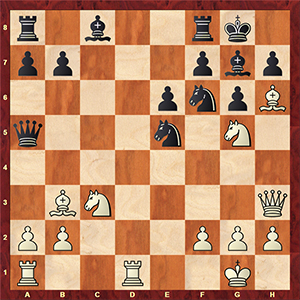
This is another example of White ditching a pawn at a very opportune moment and a computer evaluation is about equality, but it's much easier to play with the white pieces. Thanks to Kharchenko, a young player, who helped me so much with the opening preparation shortly before the game.
17.Rd4 Nc6 18.Ra4 Qf5?!
This is a loss of a tempo as the queen belongs to е5, while the white queen is stationed better on h4 than on h3. 18...Qe5.
19.Qh4 Rd8? (19...Qe5) 20.Re1?
Here I missed a nice win 20.Bxg7 Kxg7 21.Rf4 Qe5 22.Nf3 g5 23.Nxg5 Rd4 24.Qg3!, and Black has nowhere to retreat.
20...Rd4 (20...Bxh6 21.Qxh6 Rd2 22.Nce4 b5 23.Ra3 Rxf2 24.Nxf6+ Qxf6 25.Qxh7+ Kf8 26.Bd5).
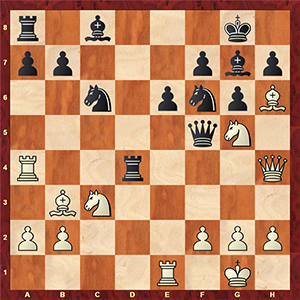
Now the path to victory is longer and more challenging, but I managed to have it all calculated.
21.Rxd4 Nxd4 22.Bxg7 Kxg7 23.Qxd4 Qxg5 24.h4 Qg4 (24...Qa5 25.g4 e5 26.Rxe5 Qb6 27.Qxb6 axb6 28.g5 would have been a tougher resistance, which does not save Black, though) 25.Re4! Qf5 26.Re5! Qg4 27.Ne4 b6 28.Bd1 Qxh4 29.g3 Qh6 30.Nxf6 Bb7 31.Rh5 e5 32.Qxe5 Rd8 33.Nd7+. 1-0.
A third Superfinal of Kuzbass and a third crucial and beautiful victory. However, other places and other times had luck on my opponent's side more often than not.
Vlassov – Nevostrujev
Kemerovo (rapid) 2015
1.e4 c5 2.c3 Nf6 3.e5 Nd5 4.d4 cxd4 5.cxd4 d6 6.Bc4 Nb6 7.Bb3 dxe5 8.Qh5 e6 9.dxe5 Nc6 10.Nc3 Qd3 11.Nf3.
Better is 11.Be3 Bd7 or 11.Bd2 Nc4 12.0–0–0, but, having employed this move on more than one occasion, I hoped to get by with it. Well, this time I did not.
11...Nc4!
With the dark-squared bishop deprived of the d2-square, White has serious issues with castling and facing Bb4.
12.Qg5. 12.a3 b6 (12...Nxa3 13.Ng5 Nxe5 14.f4 Ng6 15.Qe2) 13.Bd1 Nxa3 14.Bd2 Nc2+ 15.Bxc2 Qxc2 16.0–0 Be7 17.Nb5 0–0 18.Nc7 Rb8.
12...Bd7 13.Bxc4?! (13.Qf4 Nb4 14.Ng5 Qxc3+ 15.bxc3 Nd3+ 16.Ke2 Nxf4+ 17.Bxf4) 13...Qxc4 14.Qf4 Qa6 15.Ng5.
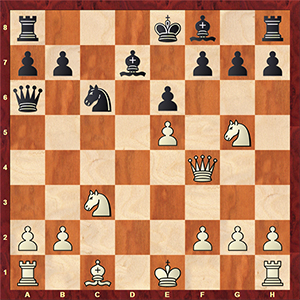
Hoping to get away with a passive defensive stance, but...
15...0–0–0! (absolutely!) 16.Qe3?!
The position is already lost from a human player point of view, but the engine shows a way out after 16.Be3 Nb4 17.0–0–0! Nxa2+ 18.Nxa2 Qxa2 19.Qd4! Qa1+ 20.Kd2 Qa5+ 21.Kc1 Be8 22.Qxa7 Qxa7 23.Bxa7 Be7 24.Be3.
16...Be8 (now Black's edge is decisive) 17.Nf3 Nb4 18.Qe2 Nd3+ 19.Kf1 Bb4 20.Bg5?! Bxc3 21.bxc3 Bb5 22.a4 Bc4 23.Nd2? (23.Kg1 Nf4 24.Qe1 Ne2+ 25.Kf1 Rd5).
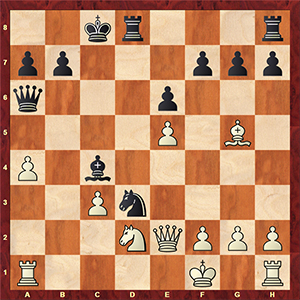
23...Nc1! A textbook checkmate to wrap up the article. 0-1.
This is how curiosity, fighting spirit and stubbornness, worthy of a better application, allow the oldies performing spectacularly and meaningfully in an opening line known to be boring and theoretically drawish.




















